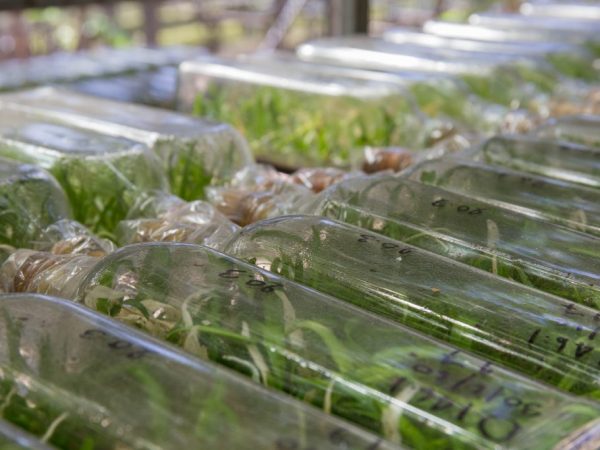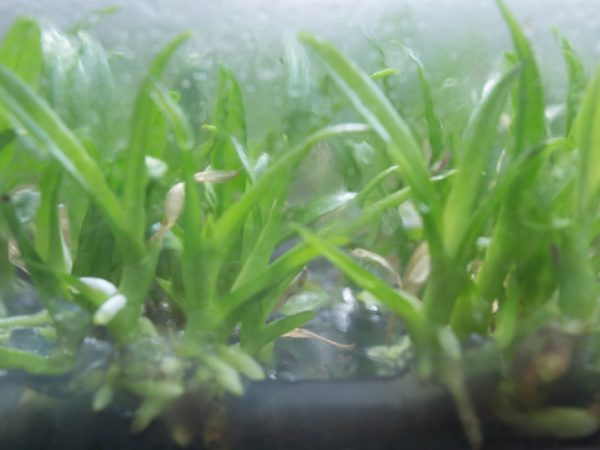Rules for planting orchids in a closed system
The closed system growing technique is gaining popularity due to its simplicity and efficiency. Planting an orchid in a closed system consists in the fact that the flower is planted in a container without holes, and water is poured into the bottom of the pot.

Rules for planting orchids in a closed system
Growing principle
When phalaenopsis is kept in a closed system, the influence of the external environment is reduced. The method is carefully described by the florist Yulia Aksenova, and Olga Kovalenko plants even in a tank for aquariums.
The method is suitable for dry climates. A plant planted with this principle remains moist. The roots will stretch downward, which will ensure the integrity and growth of the root system - this will facilitate the rapid growth of leaves and peduncles.
Growing an orchid in a closed container only touches the roots; the ground part of the plant develops under normal conditions. A flower planted this way requires less attention.
Advantages of the method:
- the culture blooms for a long time;
- the root begins to grow faster;
- a natural living environment is created.
Cons of growing: decay of the root collar, which will lead to the death of the plant, and high levels of humidity.
Landing
Planting a plant is carried out not only for growing, but also for reanimating a flower for a certain period.
The flower should be:
- healthy, no signs of disease;
- with a strong root system;
- with well-developed leaves.
Planting also helps to save a diseased tree that has lost its root system as a result of decay. After placing a crop without leaves in a tight pot, it comes to life. The flower grows roots and begins to bloom.
Choice of capacity
A glass container is suitable as a pot. It is more stable and has a beautiful appearance in comparison with plastic containers. Glass has no porous structure, so the roots of the plant will not grow in.
Choosing a transparent vessel, it is easier:
- control the water level;
- observe the growth of roots;
- see the general condition of the plant.
The shape is chosen even or with edges expanding upward, so as not to damage the root system during transplantation.
Children and small orchids are placed in all kinds of containers:
- wineglass;
- pots;
- beer mugs;
- glass;
- small aquarium.
For large plants, choose a voluminous pot. The plastic container is used only as a temporary transplant vessel. Holes can be made in it at any time if the growing method does not work.
The main components of the substrate
Orchid substrate in a closed growing system consists of certain components that must not be mixed. They are laid in layers.
Substrate composition:
- sphagnum moss;
- expanded clay;
- pine bark;
- charcoal.
Pieces of bark are made 1-3 cm each so that moist air can freely pass between the pieces. This will get rid of mold during cultivation. Cones can be analogous to the bark.
Sphagnum moss has disinfecting and antibacterial properties, so it does not need to be processed, like other components. It is recommended to collect it yourself, or when buying, choose moss where there are small green branches.
Such a substrate keeps the root intact and protects it from decay.
Planting process

We follow all the recommendations for planting
Phalaenopsis in a closed system is grown according to the following rules:
- The container is treated with boiling water for disinfection or sterilized.
- At the bottom, the expanded clay drainage is poured in the first layer, which should place about ¼ of the pot, this is about 3 cm.
- Sphagnum moss is laid in a layer up to 0.5 cm.
- The remaining space is filled with bark and charcoal.
- The substrate is poured with settled warm water and left for half an hour.
- The remaining liquid is drained and a flower is planted. A little moss is laid with the top layer, as mulch.
The roots should not reach the expanded clay with water. After the actions taken, the flowerpot is placed in a permanent place.
Care
Orchid care consists of replanting (if necessary), watering and proper feeding.
Transfer
The plant may need a transplant if the root system does not fit into the pot. The plant is transplanted in the phase of intensive growth (this way the orchid will more easily endure stress). The bush is transplanted with a small amount of soil on the roots, but cutting off dry or decayed ends.
Top dressing
The flower is fed in a closed system with a lower intensity. Standard orchid fertilizers are used:
- Kemira Lux;
- "BonaForte";
- Cameleon.
The dosage is reduced 10 times from the instructions in the instructions.
Only mineral solutions are used for feeding. Do not fertilize during flowering, within 10 days after transplanting, in hot weather.
Feeding methods:
- bring in dissolved form;
- spray over the green mass and visible root system;
- added to water intended for irrigation.
Fertilizers should contain, in addition to nitrogen, phosphorus and potassium, also manganese, magnesium and boron. Trace elements increase the immunity of the flower.
Watering features
The orchid, gaining access to moisture, begins to grow faster. Therefore, the amount of water and the regularity of watering is an important step in maintenance. Expanded clay should always be moist - this allows the plant to draw moisture from the bottom of the substrate.
To determine when to water the flower, look for condensation drops on the inside of the container. If they are, then watering is not required.
The color of the root serves as a guide for adding water. If it is green - the substrate is moist, light gray - the plant needs watering.
Water the flower with a watering can along the inner wall of the container to the level of expanded clay. It is also possible to immerse the pot in a container of water for 20 minutes. The main thing is to adjust the watering frequency according to the microclimate in the apartment.
Diseases and pests
A wet substrate is loved by midges. The optimal insect repellent is dry mustard powder, which is sprinkled on top of the substrate.
If thrips and scale insects are found on the flower, treat it with one of the solutions (reducing the dosage):
- Aktara;
- Actellik;
- Fitoverm.
The processing interval is 10 days, the number of sprays is 3-4.
If root rot and blackening of the leaves is observed, this is a sign of powdery mildew, anthracnose, or leaf blight. Such a plant does not respond to treatment.
When only the root rots, it is urgently removed from the substrate, washed with water, the decayed parts are cut off and dried within 4 days. Then they completely change the substrate in the container and plant the flower back.
Conclusion
Growing Phalaenopsis orchids in a closed system allows it to grow effectively in any conditions. With proper care and adherence to all the rules, you can get a healthy and beautiful plant.


